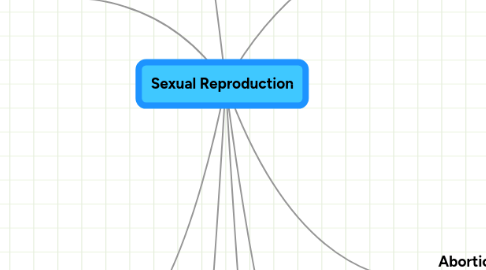
1. Reproductive organs
1.1. Male
1.1.1. Testis
1.1.1.1. Produces Sperms
1.1.2. Scrotum
1.1.2.1. Keep the testis and the penis out of the body
1.1.3. Epididymis
1.1.3.1. Where sperms produced by the testis are stored
1.1.4. Urethra
1.1.4.1. Tube which carriers both sperm and urine out of the body
1.1.5. Sex Glands
1.1.5.1. Releases fluid that nourishes and protects the sperms, and forms semen
1.1.6. Sperm Duct
1.1.6.1. Tube that carriers sperms from the epididymis to the urethra
1.2. Female
1.2.1. Fallopian tube
1.2.1.1. Carries ovum to uterus, and has cilia to sweep ovum to the urerus
1.2.2. Vagina
1.2.2.1. Site where sperms are deposited during sexual intercourse
1.2.3. Ovary
1.2.3.1. Produces sex hormones and ova
1.2.4. Cervix
1.2.4.1. Neck of the uterus which widens during child birth
1.2.5. Uterus
1.2.5.1. Structure whereby the fertilised ovum is implanted in, and also where ovum is developed into zygote and foetus during pregnancy
2. Fertilisation
2.1. Sperm meets an ovum and fuses together through the insertion of the penis into the female's vagina
2.2. Semen is ejaculated, following by the sperms swimming up the Fallopian tube
2.3. Sperm meets the ovum in the Fallopian tube and fertilisation occurs
2.3.1. One sperm penetrates through the cell membrane
2.3.2. Nuclei of sperm and ovum fuse together
2.3.3. Fertilised egg is called the zygote
2.3.4. Passes along the Fallopian tube to the uterus
2.3.5. Zygote divides repeatedly to form embryo
2.3.6. Embryo gets implanted in the thick uterine lining, undergoes differentiation to form a foetus
2.3.7. Foetus gets nourishment from the mother through the placenta
3. Heredity
3.1. The transmission of genetic characteristics from parents to offspring
3.1.1. Sperm which contains father's DNA
3.1.2. Ovum which contains mother's DNA
3.1.3. Zygote contains mixture of father and mother's DNA
4. Birth control
4.1. Preventing fertilisation
4.1.1. Condom
4.1.1.1. Worn over the erected penis
4.1.1.2. Barriers the eggs and sperms
4.1.2. Diaphragm
4.1.2.1. Placed over the cervix
4.1.2.2. Barriers the spemrs and eggs
4.1.3. Spermicide
4.1.3.1. Kills sperms
4.2. Preventing ovulation
4.2.1. Contraceptive pills
4.2.1.1. Contains synthetic female sex hormones
4.2.1.2. Suppresses the development and release of the eggs
4.3. Preventing the development of a fertilised egg
4.3.1. Intra-uterine device
4.3.1.1. Inserted into the uterus, which prevents implantation of the fertilised egg in the uterus
4.4. Sterilisation
4.4.1. Ligation (Females)
4.4.1.1. Tie and cut Fallopian tubes
4.4.2. Vasectomy (Males)
4.4.2.1. Tie and cut the sperm duct
4.4.3. A person's ability to reproduce is permanently removed, and this process is irreversible
5. Puberty
5.1. Male
5.1.1. Become muscular and shoulders broaden
5.1.2. Testis and penis increase in size
5.1.3. Height rapidly increases
5.1.4. Reproductive system becomes active
5.1.5. Ejaculation starts
5.1.6. Hair grows on face, chest, pubic areas
5.2. Female
5.2.1. Ovaries and vagina increase in size
5.2.2. Menstruation occurs
5.2.3. Hair grows on face, pubic areas
5.2.4. Hips widen and become rounder
5.2.5. Height rapidly increases
5.2.6. Reproductive system becomes active
5.2.7. Breast develop
6. Menstrual Cycle
6.1. Menstruation
6.1.1. Day 1-5 of the cycle
6.1.2. Uterine lining, unfertilised egg and blood are shed with the help of muscular contractions of the uteris
6.1.3. Contractions cause cramps
6.2. Thickening of uterine lining
6.2.1. To prepare for implantation, the lining thickens and becomes spongy, and full of capillaries
6.3. Ovulation
6.3.1. Day 14-16 of the cycle
6.3.2. A mature ovum is released from an ovary
6.3.3. Considered the most fertile period
6.4. When it stops
6.4.1. Temporary
6.4.1.1. When a person is pregnant, menstruation stops but thick uterine wall is maintained to cushion the developing fertilised ovum
6.4.2. Permanent
6.4.2.1. Stops at menopause onwards, which happens after 50 years old+
7. Abortion
7.1. Causes physical, emotional, and social issues if pregnancy is unwanted
7.2. The deliberate termination of a pregnancy
7.3. Use surgical procedure to remove the developing embryo or foetus from the mother's uterus
7.4. Complications may rise
7.4.1. Infections of the uterus or Fallopian tube can cause infertility
7.4.2. Heavy bleeding due to accidental puncturing of the uterus
7.4.3. Weakening and damage of the cervix and uterus
7.4.4. Emotional problems
8. Sexually transmitted infections
8.1. Caused by viruses and micro-organisms
8.2. Transmitted by:
8.2.1. Skin to skin contact
8.2.2. Contact with bodily fluids
8.2.3. From infected mother to foetus
8.2.4. From infected mother to baby during childbirth
8.3. Different infections
8.3.1. Gonorhea
8.3.1.1. Caused by sperical bateria
8.3.1.2. Transmitted through
8.3.1.2.1. Sexual intercourse
8.3.1.2.2. Mother to baby through childbirth
8.3.1.3. Symptoms
8.3.1.3.1. Painful sensation during urination
8.3.1.3.2. Discharge of pus from the penis or vagina
8.3.1.3.3. Infection of urethra of Fallopian tubes causing infertility
8.3.1.3.4. Newborn may be blind
8.3.1.4. Can be treated with anti-biotics
8.3.2. Syphilis
8.3.2.1. Caused by spiral bacteria
8.3.2.2. Transmitted through
8.3.2.2.1. Sexual intercourse
8.3.2.2.2. Mother to foetus during pregnancy
8.3.2.3. Symptoms
8.3.2.3.1. Painless sores on penis,vagina,cervix,mouth
8.3.2.3.2. Non-itchy skin rash
8.3.2.3.3. Deformed joints
8.3.2.3.4. Paralysis
8.3.2.3.5. Foetus infected by mother may be deaf, or have abnormal teeth and bone
8.3.2.3.6. Can be treated with antibiotics at early stages
8.3.3. Acquired Immune Deficiency Syndrome
8.3.3.1. Caused by Humans Immunodeficiency Virus
8.3.3.2. Transmitted through
8.3.3.2.1. Sexual intercourse
8.3.3.2.2. Sharing of injection needles with infected people
8.3.3.2.3. Blood transfusion
8.3.3.2.4. Infected mother to child during pregnancy or childbirth
8.3.3.3. Symptoms/effects
8.3.3.3.1. HIV attacks white blood cells, therefore the immune system of the person is reduced
8.3.3.3.2. Other infections and cancers will affect the person
8.3.3.4. Currently no cure
